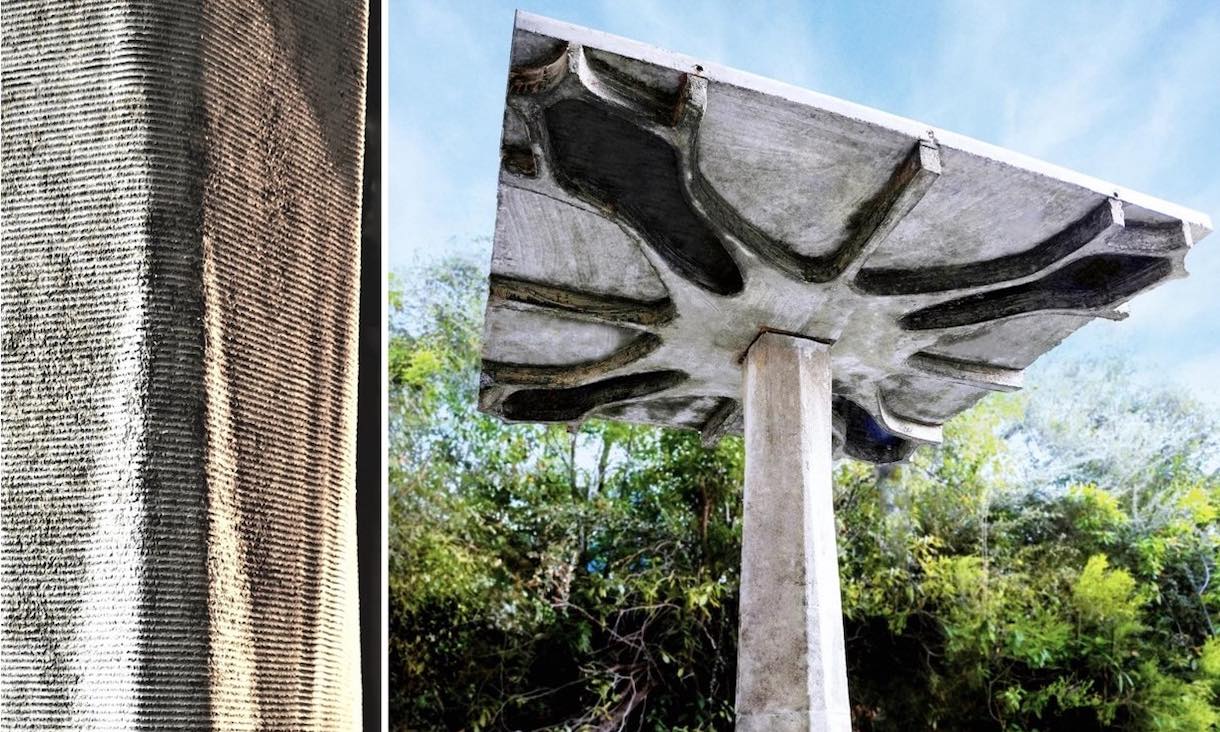PrintNervi – Design and construction of a ribbed floor system in the digital era, Melbourne Australia, 2022

About the project
In the 20th century, the famous engineer Pier Luigi Nervi (1891–1979) significantly explored the design and construction of free-form ribbed slabs and columns for floor systems. This research project, named PrintNervi, aims to revisit Nervi’s distinguished system by leveraging the latest structural design and construction techniques, so as to improve the digitization and sustainability of the building industry.
In this project, a modified topology optimization method is developed to enhance the structural stiffness of ribbed floors. The optimized ribbed slab exhibits higher stiffness than Nervi’s original slab design for the Gatti Wool Factory. Combining robotic 3D printing with CNC machining, we develop a rapid fabrication process for free-form geometries with minimal material usage and adequate rigidity. The generated formwork is reusable and recyclable. A large-scale floor unit is constructed as a proof of concept.
Redesign ribbed slab
A modified BESO algorithm with a constraint mapping and structural complexity control approach is developed to optimize the stiffness of ribbed slabs. The ribbed slab design from Nervi’s Gatti Wool Factory was chosen to undergo the optimization process and evaluate the prospective design improvement. Compared with Nervi’s original design, the proposed topology optimization algorithm in this study shows a considerable improvement of 26.3% in the structural stiffness of the ribbed slab.
Digital fabrication and construction
A new digitally fabricated formwork system is developed to provide high geometrical complexity and accuracy using less labour and a shorter fabrication time, while also being reusable and recyclable. This is achieved by utilizing a hybrid fabrication method that combines both robotic 3D printing and CNC machining. To prove the capability of the new formwork, a 2,200 mm × 2,200 mm × 130 mm concrete slab using our optimised design and a 2,500 mm × 476 mm × 476 mm concrete column using Nervi’s design is constructed and assembled. Steel reinforcements are implemented to provide extra tensile strength for the concrete. The assembly mechanism and process are also investigated to facilitate construction. Furthermore, the used formwork can be reused and recycled.
Overall, the design and construction methods developed from this project offer a contemporary evolution of Nervi’s pioneering techniques for creating ribbed floor systems. The new workflow promises higher efficiency and sustainability for creating ribbed floor systems in modern architectural and engineering applications. Nervi’s design and construction concepts were ground-breaking and are still considered pioneering, even by today’s standards.
Publication
J. Ma, M. Gomaa, D. W. Bao, A. R. Javan, Y. M. Xie, “PrintNervi – Design and construction of a ribbed floor system in the digital era,” in Innovation, Sustainability and Legacy: Proceedings of the IASS Annual Symposium 2022 and the 13th Asian-Pacific Conference on Shell and Spatial Structures, Beijing, China, September 19–22, 2022, S. Xue, J. Wu, and G. Sun Eds. 2022. [Full paper]
Award
The 20th IASS Hangai Prize by the international association for shell and spatial structures.
Plenary presentation
- YouTube: https://www.youtube.com/watch?v=PXKcapkkkkQ
- Bilibili: https://www.bilibili.com/video/BV1E14y1Y7kd/?vd_source=6b6160fa10d6246e9c46ccd2d0ee1803
Key people involved in the project
- RMIT CISM: Jiaming MA, Mohamed GOMAA, Ding Wen ‘Nic’ BAO, Anooshe R. JAVAN, Yi Min ‘Mike’ XIE, Yunzhen He, Ting-Uei ‘Jeff’ Lee, Anbang Chen
- RMIT Architecture: Hesameddin Mohamed
- RMIT Light Structure Laboratory: Xiang ‘Eric’ Gao
- RMIT Technical Service Manufacturing & Fabrication: Mark Overend
- EZSTEEL: Dong Fu


